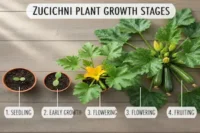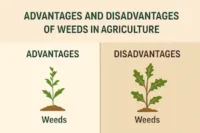Cilantro Growth Stages: How to Grow & Harvest Cilantro Easily
Published: 16 Feb 2025
Cilantro (Coriandrum sativum) is an annual herb that belongs to the parsley family. Its leaves are widely used in cuisines around the world, especially in Mexican, Indian, and Middle Eastern dishes. The seeds of the plant are called coriander and have their own unique flavor, often used as a spice. Cilantro is rich in vitamins A, C, and K. It also helps with digestion and may even remove heavy metals from the body.
By understanding the growth stages of cilantro you can provide the right care at each stage. From germination to maturity, knowing when to water, prune, and harvest ensures a healthy and productive plant. Whether growing cilantro in a garden or indoors, learning about its life cycle can help you get the best results.
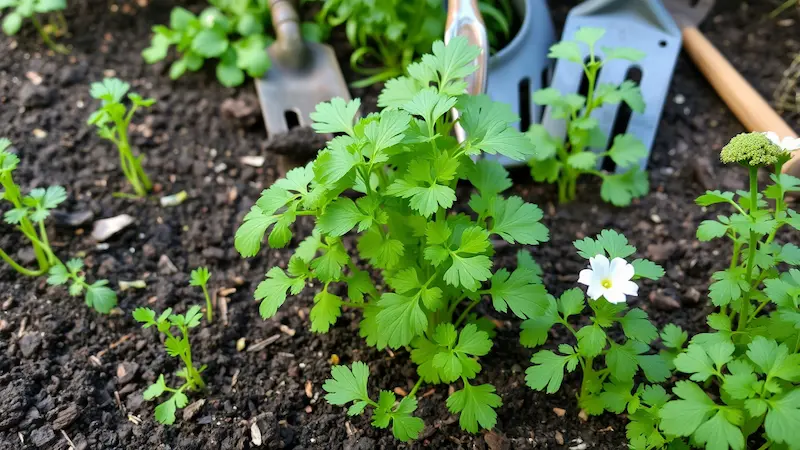
Cilantro Growth Stages
Cilantro has several stages from seed to harvest. Each stage requires specific care for healthy growth. Below is a detailed breakdown of its growth cycle.
Germination Stage (0-7 Days)
Cilantro seeds begin their journey by germinating in the soil. They take about 5-7 days to sprout under the right conditions. For successful germination. It Keeps the soil moist but not soggy. The ideal temperature range for germination is 50-85°F (10-29°C). Cooler temperatures slow germination.
Tip: Soak the seeds in water for a few hours before planting to speed up sprouting.
Seedling Stage (7-21 Days)
Once the seeds sprout, tiny green leaves start to appear. This is the seedling stage. Proper care is essential at this stage. Keep the soil evenly moist. Seedlings need 4-6 hours of direct sunlight daily. Spacing the thin seedlings to 3-4 inches apart to prevent overcrowding.
Vegetative Stage (3-5 Weeks)
At this stage, the cilantro plant grows true leaves, becoming stronger and bushier. The true leaves look feathery and have a stronger scent. Regularly trim the outer leaves to promote new growth. A light application of balanced fertilizer can boost growth.
Tip: Avoid high-nitrogen fertilizers as they can weaken the flavor.
Maturity Stage (6-8 Weeks)
At this stage, cilantro reaches full size and is ready for harvest. The leaves are lush and have the best flavor during this stage. Pick leaves regularly to encourage new growth. Before the plant starts flowering harvest the cilantro as this keeps the flavor fresh.
Tip: Cutting 1-2 inches above the soil allows multiple harvests.
Bolting and Flowering Stage (8+ Weeks)
As temperatures rise, cilantro starts bolting, meaning it sends up a flower stalk. The leaves become smaller and bitter. Keep the soil cool with mulch and harvest leaves often.
Tip: If you want more leaves, cut off flower stems early to delay bolting.
Seed Formation (Coriander Seeds) (10+ Weeks)
After flowering, cilantro develops small green seed pods that dry into coriander seeds. As pods turn brown then harvest them. Keep seeds in a dry place for replanting or cooking.
Tip: Crushed coriander seeds add great flavor to dishes and spice mixes.
By understanding these growth stages, you can grow cilantro successfully and enjoy its fresh leaves or flavorful seeds. Would you like any additions or modifications?
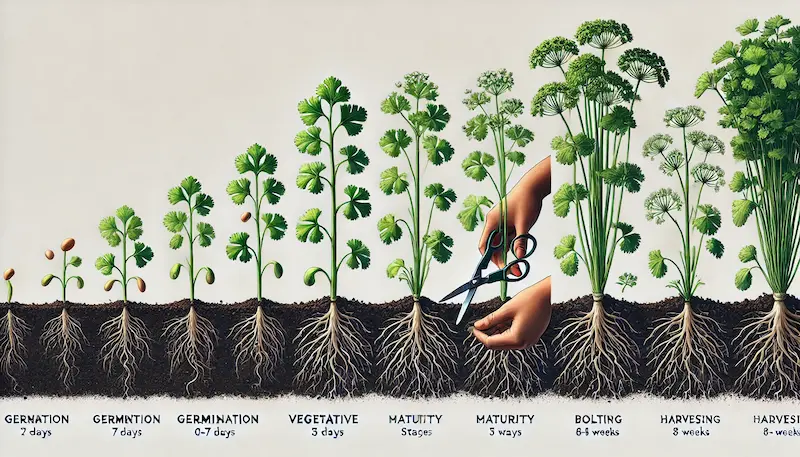
How to Grow Cilantro from Seed?
Growing cilantro from seed is easy if you follow the right steps. Here’s how you can do it:
1. Choose the Right Seeds
- Buy high-quality cilantro seeds (also called coriander seeds).
- Choose slow-bolting varieties for a longer harvest.
2. Prepare the Soil
- Use well-draining soil rich in organic matter.
- Maintain a pH level of 6.2 to 6.8 for best growth.
- Loosen the soil to improve drainage and root development.
3. Planting the Seeds
- Sow seeds directly in the garden or a pot (cilantro doesn’t transplant well).
- Plant seeds ¼ inch deep and 2 inches apart.
- Lightly cover them with soil and water gently.
4. Watering and Sunlight
- Keep the soil moist but not soggy.
- Provide 4-6 hours of sunlight daily.
- In hot climates, plant in partial shade to prevent early bolting.
5. Caring for Cilantro Plants
- Thin seedlings when they reach 2 inches tall, keeping them 3-4 inches apart.
- Fertilize lightly with a balanced organic fertilizer.
- Mulch the soil to retain moisture and keep roots cool.
6. Harvesting Cilantro
- Begin harvesting when plants are 6-8 inches tall (around 4-6 weeks after planting).
- Cut the outer leaves first and leave the center intact for continuous growth.
- For coriander seeds, allow the plant to flower and dry before collecting seeds.
By following these steps, you can successfully grow cilantro from seed and enjoy a fresh supply of flavorful leaves! Let me know if you’d like more details on any section.
How to Grow Cilantro Indoors
Growing cilantro indoors in containers is very easy and perfect for small spaces. Follow these steps for a healthy harvest.
1. Choose the Right Container
- Use a pot at least 8-12 inches deep to allow root growth.
- Make sure the container has drainage holes to prevent waterlogging.
2. Select the Best Soil
- Use a well-draining potting mix rich in organic matter.
- Avoid compact soil; loose and airy soil helps roots grow better.
3. Planting Cilantro Seeds
- Sow seeds directly in the container (cilantro doesn’t transplant well).
- Plant seeds ¼ inch deep and scatter them evenly across the soil.
- Lightly cover with soil and water gently.
4. Provide Proper Sunlight & Temperature
- Place the container in a spot with 4-6 hours of sunlight daily.
- Keep the temperature between 50-85°F (10-29°C) for healthy growth.
- In hot climates, provide partial shade to prevent bolting.
5. Watering & Care
- Keep the soil moist but not soggy—water when the top inch of soil feels dry.
- Mulch the soil with a thin layer of straw or dry leaves to retain moisture.
- Avoid overwatering, as cilantro’s roots are sensitive to rot.
6. Fertilizing Cilantro
- Use a balanced liquid fertilizer every 2-3 weeks.
- Avoid high-nitrogen fertilizers, which can weaken the flavor.
7. Harvesting Cilantro in Containers
- Start harvesting when plants reach 6-8 inches tall (about 4-6 weeks).
- Cut outer leaves first, leaving the inner part for continuous growth.
- For coriander seeds, let the plant flower and collect seeds once dry.
8. Tips for Healthy Growth
- Succession planting: Sow new seeds every 2-3 weeks for a continuous supply.
- Pinch off flowers early to extend the leaf-growing phase.
- Move containers indoors during extreme heat to prevent bolting.
Growing cilantro in containers is simple and rewarding. Follow these steps, and you’ll have fresh, flavorful leaves at home.
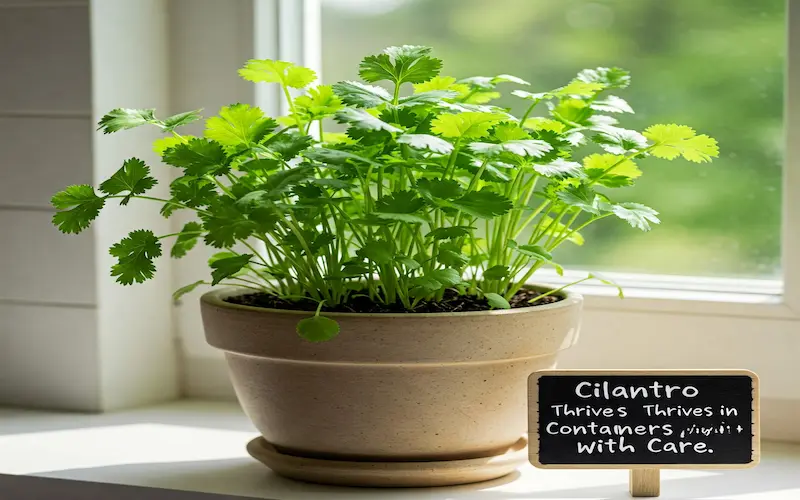
How to Transplant Cilantro Seedlings?
Cilantro doesn’t like being transplanted, but if done carefully, you can still move the seedlings successfully. Follow these steps for the best results.
1. Choose the Right Time
- Transplant when seedlings are 2-3 inches tall with at least two sets of true leaves.
- Move them early in the morning or late in the evening to avoid heat stress.
2. Prepare the New Planting Area
- Use well-draining, nutrient-rich soil with a pH of 6.2-6.8.
- Choose a spot with 4-6 hours of sunlight and shade in hotter climates.
- Water the soil before transplanting to keep it moist.
3. Carefully Remove Seedlings
- Water the seedlings an hour before transplanting to reduce shock.
- Gently loosen the soil around the roots with a spoon or small trowel.
- Lift each seedling by the leaves, not the stem, to prevent damage.
4. Transplanting the Seedlings
- Dig small holes 2-3 inches apart in the new location.
- Place each seedling at the same depth it was growing before.
- Gently cover the roots with soil and press lightly to remove air pockets.
5. Watering and Care After Transplanting
- Water the seedlings immediately after transplanting to help roots settle.
- Keep the soil moist but not waterlogged for the next few days.
- Provide shade for 2-3 days to help seedlings adjust to their new home.
6. Tips for a Successful Transplant
- Use biodegradable pots if possible to avoid root disturbance.
- Avoid disturbing the roots too much, as cilantro has a delicate taproot.
- Mulch the soil lightly to retain moisture and reduce stress.
- If transplanting to containers, choose at least an 8-inch deep pot for good root growth.
Transplanting cilantro can be tricky, but with careful handling, your plants will thrive. Let me know if you need more details.
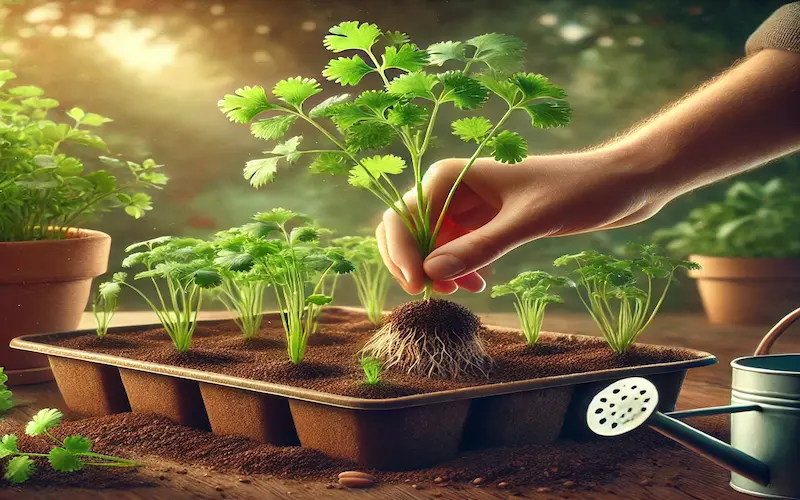
When to Plant Cilantro?
Cilantro grows best in cool weather. Here’s the best time to plant it for a healthy harvest.
1. Best Seasons for Planting
- Spring (After Last Frost): Ideal for cool-season growth.
- Fall (Late Summer to Early Fall): Helps avoid bolting in hot regions.
- Winter (Mild Climates): Can grow year-round in frost-free areas.
2. Temperature Requirements
- Grows best in 50-85°F (10-29°C) temperatures.
- Avoid planting in extreme summer heat to prevent bolting.
- If growing in hot weather, plant in partial shade for better results.
3. Indoor Planting Time
- Start seeds indoors 2-4 weeks before the last frost for an early harvest.
- Grow indoors year-round with good sunlight (4-6 hours daily).
4. Succession Planting for Continuous Harvest
- Sow new seeds every 2-3 weeks to get a steady supply of fresh leaves.
- This prevents all plants from flowering at once and extends the harvest season.
5. Avoiding Bolting
- Cilantro bolts quickly in warm weather, so plant it in spring or fall.
- Use slow-bolting varieties for longer leaf production.
- Mulch the soil to keep roots cool and delay bolting.
By planting cilantro at the right time, you’ll enjoy fresh leaves for a longer period. Let me know if you
How to Plant Cilantro
Planting cilantro is simple and rewarding. Follow these easy steps for a healthy harvest.
1. Choose the Right Location
- Select a cool, sunny spot with 4-6 hours of sunlight daily.
- In hot climates, choose partial shade to prevent bolting.
- Use well-draining soil with a pH of 6.2-6.8 for best growth.
2. Prepare the Soil
- Loosen the soil to about 6-8 inches deep for better root growth.
- Mix in compost or organic matter to improve fertility.
- Ensure the soil stays moist but not waterlogged.
3. Planting the Seeds
- Sow seeds directly into the soil or containers.
- Plant seeds ¼ inch deep and space them 1-2 inches apart.
- Lightly cover with soil and water gently.
4. Watering & Care
- Keep the soil evenly moist but avoid overwatering.
- Water when the top inch of soil feels dry.
- Use mulch to retain moisture and keep roots cool.
5. Germination & Thinning
- Seeds take 7-10 days to germinate in warm conditions.
- Once seedlings are 2 inches tall, thin them to 6 inches apart for proper growth.
6. Providing Proper Sunlight & Temperature
- Ideal temperature: 50-85°F (10-29°C).
- Protect from strong heat by providing shade or afternoon cover.
7. Harvesting Cilantro
- Begin harvesting when plants are 6-8 inches tall (about 4-6 weeks).
- Cut outer leaves first, leaving the center for continuous growth.
- Harvest regularly to delay bolting and extend leaf production.
8. Tips for Success
- Succession planting: Sow new seeds every 2-3 weeks for a continuous harvest.
- Avoid transplanting: Cilantro has a delicate taproot and dislikes being moved.
- For coriander seeds: Allow plants to flower and collect dried seeds.
Plant cilantro at the right time and care for it properly to enjoy fresh, flavorful leaves.
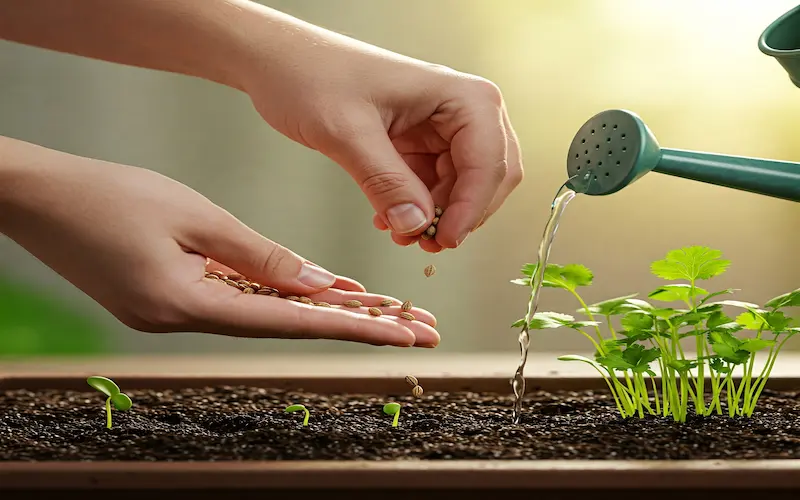
How to Harvest Cilantro?
Harvesting cilantro at the right time ensures the best flavor and continuous growth. Follow these simple steps for a fresh and healthy harvest.
1. Best Time to Harvest
- Start harvesting when the plant is 6-8 inches tall (about 4-6 weeks after planting).
- Pick leaves before the plant bolts (produces flowers) for the best taste.
- Harvest in the morning for the freshest leaves.
2. Harvesting Cilantro Leaves
- Use sharp scissors or garden shears to cut the outer leaves first.
- Leave at least ⅓ of the plant so it continues to grow.
- Trim stems 1-2 inches above the soil to allow regrowth.
- Avoid pulling the whole plant unless harvesting the entire crop.
3. Continuous Harvesting
- Pick leaves every 1-2 weeks to promote new growth.
- Regular cutting helps delay bolting and extends the harvest period.
- If cilantro bolts, the leaves turn bitter, so harvest early.
4. Harvesting Cilantro Seeds (Coriander)
- Let the plant flower and produce seed pods.
- Once the pods turn brown and dry, cut the stems and hang them upside down.
- Place a paper bag around the pods to catch the seeds.
- Store dried coriander seeds in an airtight container for replanting or cooking.
5. Storing Fresh Cilantro
- Refrigeration: Wrap in a damp paper towel and place in a ziplock bag for 5-7 days.
- Freezing: Chop leaves and freeze them in ice cube trays with water for long-term storage.
- Drying: Hang stems upside down in a dry, dark place, then store in an airtight jar.
6. Tips for a Better Harvest
- Harvest often to keep the plant producing fresh leaves.
- Plant new seeds every 2-3 weeks for a continuous supply.
- If growing in hot weather, provide shade to prevent bolting.
With these steps, you can enjoy fresh cilantro for a longer time.
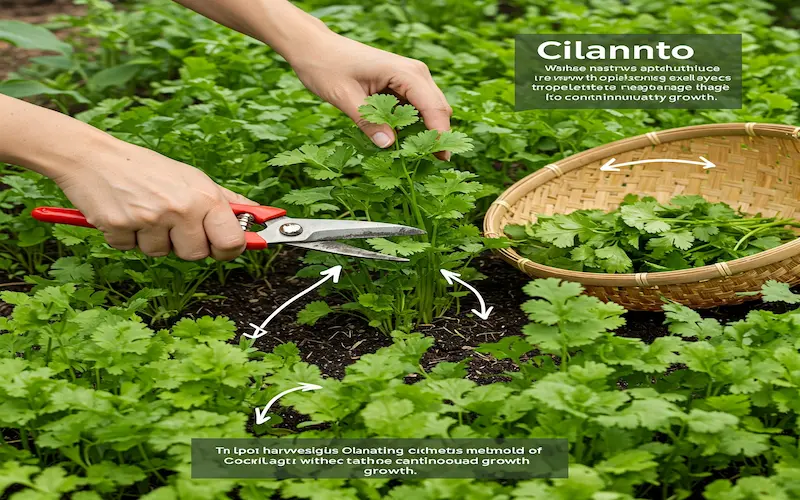
Best Cilantro Varieties
Choosing the right cilantro variety helps improve yield, flavor, and resistance to bolting. Here are some of the best types of cilantro you can grow.
1. Slow-Bolting Varieties (Best for Hot Climates )
These varieties take longer to flower, giving you more time to harvest fresh leaves.
- ‘Calypso’ – One of the slowest to bolt, with high leaf production.
- ‘Leisure’ – Popular for its strong aroma and delayed bolting.
- ‘Santo’ – Fast-growing and stays leafy longer before flowering.
- ‘Cruiser’ – Grows upright with large, flavorful leaves.
2. Fast-Growing Varieties (Best for Quick Harvest )
If you want fresh cilantro fast, these varieties grow quickly.
- ‘Caribe’ – Strong flavor with quick leaf growth.
- ‘Long Standing’ – Stays green longer but grows fast.
- ‘Jantar’ – Quick to grow and highly aromatic.
3. Specialty Cilantro Varieties (Unique Flavor & Uses )
- ‘Delfino’ – Feathery, dill-like leaves with a milder taste.
- ‘Vietnamese Cilantro’ (Persicaria odorata) – Stronger, spicier flavor, great for Asian dishes.
- ‘Moroccan Cilantro’ – Known for its slightly citrusy taste.
4. Coriander Seed Varieties (For Spices & Replanting )
These varieties are ideal if you want to harvest coriander seeds.
- ‘Indian Coriander’ – Produces large, flavorful seeds for spice.
- ‘Russian Coriander’ – Grows tall with abundant seeds.
Which Cilantro Variety Should You Choose?
- For extended harvest? ‘Calypso’ or ‘Santo’
- For hot climates? ‘Leisure’ or ‘Cruiser’
- For coriander seeds? ‘Indian Coriander’
- For unique texture? ‘Delfino’
By selecting the right variety, you can enjoy fresh cilantro for a longer time.
How to Store Cilantro
Storing cilantro properly helps keep it fresh and flavorful for longer. Here are the best ways to store cilantro for short-term and long-term use.
1. Storing Fresh Cilantro in the Refrigerator (Lasts 7-10 Days)
This method keeps cilantro fresh for up to a week.
Step-by-Step:
- Trim the stems slightly to remove any dried ends.
- Place the bunch in a glass of water (like a bouquet).
- Loosely cover with a plastic bag to prevent wilting.
- Store in the refrigerator and change the water every 2 days.
✅ Tip: If you don’t have space for a glass, wrap cilantro in a damp paper towel and place it in a ziplock bag.
2. Freezing Cilantro (Lasts 3-6 Months)
It is great for long-term storage while keeping its flavor.
Option 1: Freeze Whole Leaves
- Wash and dry cilantro thoroughly.
- Remove leaves from stems.
- Place leaves in a freezer bag and squeeze out excess air.
- Freeze and use directly in soups or stews.
Option 2: Freeze in Ice Cube Trays
- Chop cilantro finely.
- Fill an ice cube tray with cilantro and water (or olive oil).
- Freeze, then transfer cubes to a freezer bag.
- Use in cooking by dropping a cube into dishes.
✅ Tip: Avoid freezing fresh cilantro for salads, as it becomes soft when thawed.
3. Drying Cilantro (Lasts 1 Year)
Dried cilantro has a milder flavor but lasts the longest.
How to Dry Cilantro:
- Tie fresh cilantro into small bunches.
- Hang them upside down in a dry, dark place.
- Once fully dry (about 1-2 weeks), crumble leaves and store them in an airtight jar.
✅ Tip: Store dried cilantro away from heat and light to preserve flavor.
Common Cilantro Growing Problems & Solutions
Cilantro is easy to grow, but it can face some common problems. I will explain how to fix them
1. Slow Germination?
✅ Solution: Soak seeds overnight before planting.
- Cilantro seeds have a hard outer shell, which slows germination.
- Pre-soaking softens the shell and speeds up sprouting.
- Keep soil moist but not soggy to help seeds sprout faster.
2. Yellow Leaves?
✅ Solution: Check for overwatering or poor drainage.
- Too much water can cause root rot, turning leaves yellow.
- Make sure the soil is well-draining and not too compact.
- Water only when the top 1 inch of soil feels dry.
3. Bolting Too Soon?
✅ Solution: Keep soil cool and moist.
- Cilantro bolts (flowers early) in hot weather (above 75°F).
- Provide shade in the afternoon if temperatures are high.
- Keep soil evenly moist to prevent stress.
4. Leggy Growth?
✅ Solution: Give more sunlight and trim regularly.
- Cilantro needs 4-6 hours of sunlight daily.
- Trim the top leaves regularly to encourage bushy growth.
5. Pest Problems?
✅ Solution: Use neem oil or insecticidal soap.
- Aphids and whiteflies are common pests on cilantro.
- Spray neem oil or soapy water to keep them away.
- Attract ladybugs (natural predators) to control aphids.
6. Poor Flavor?
✅ Solution: Harvest at the right time.
- Cilantro leaves taste best before flowering.
- Pick young leaves for the strongest flavor.
Quick Troubleshooting Guide
| Problem | Solution |
| Slow germination | Soak seeds overnight |
| Yellow leaves | Reduce watering, improve drainage |
| Bolting too soon | Keep soil cool, provide shade |
| Leggy plants | Increase sunlight, trim frequently |
| Pest damage | Use neem oil or introduce ladybugs |
| Poor flavor | Harvest before flowering |
FAQs About Growing Cilantro
Cilantro takes about 6-8 weeks to reach full maturity.
- Germination: 7-10 days
- Seedling stage: 2-3 weeks
- Full growth: 6-8 weeks
- Bolting (flowering): After 8+ weeks (in warm weather)
Yes! Cilantro grows well indoors with proper care.
- Use a deep pot (at least 6 inches) with drainage holes.
- Place it in a sunny window (gets 4-6 hours of sunlight).
- Keep the soil moist but not soggy.
- Trim leaves regularly to encourage bushy growth.
Conclusion
Cilantro grows through different stages, from germination to seed formation. By understanding these stages you can provide the right care at the right time. With proper watering, sunlight, and regular harvesting, you can enjoy fresh cilantro for many days.
It is an easy-to-grow herb, beginners can confidently try growing it in their garden or even indoors in containers. With just a little effort, you can have a steady supply of fresh, flavorful cilantro for your meals. Have you tried growing cilantro? Share your experience or ask any questions in the comments below!

- Be Respectful
- Stay Relevant
- Stay Positive
- True Feedback
- Encourage Discussion
- Avoid Spamming
- No Fake News
- Don't Copy-Paste
- No Personal Attacks



- Be Respectful
- Stay Relevant
- Stay Positive
- True Feedback
- Encourage Discussion
- Avoid Spamming
- No Fake News
- Don't Copy-Paste
- No Personal Attacks

